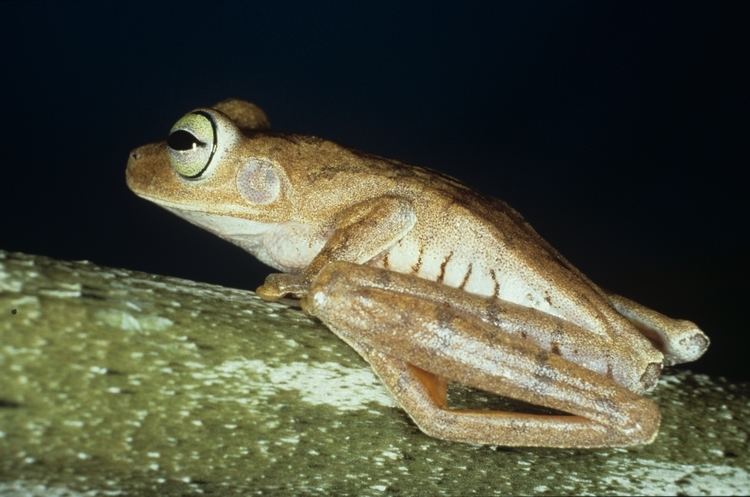Order Anura Genus Hypsiboas Higher classification Hypsiboas | Phylum Chordata Scientific name Hypsiboas crepitans Rank Species | |
 | ||
Similar | ||
The emerald-eyed tree frog, Hypsiboas crepitans, is a species of frog in the Hylidae family found in Brazil, Colombia, French Guiana, Guyana, Panama, Suriname, Trinidad and Tobago, and Venezuela. Its natural habitats are subtropical or tropical dry forests, subtropical or tropical moist lowland forests, dry savanna, moist savanna, rivers, intermittent rivers, freshwater lakes, intermittent freshwater lakes, freshwater marshes, intermittent freshwater marshes, freshwater springs, inland deltas, arable land, pastureland, plantations, rural gardens, urban areas, heavily degraded former forests, water storage areas, ponds, aquaculture ponds, irrigated land, and seasonally flooded agricultural land.
Contents
- Adult
- Dorsal
- Concealed surfaces
- Eye
- Extremities
- Habitat and Ecology
- Systems
- Breeding season
- Egg
- Tadpole
- References
This species has two disjunctive populations. The first population ranges through Panama (Azuero Peninsula, central Panama and eastern lowlands), northern Colombia (Orinoco and Caribbean regions only), most of Venezuela and partially into northern Brazil, the islands of Trinidad and Tobago and throughout much of the Guianas. The second population is largely restricted to the Atlantic Forest region of Brazil. It is present at elevations of between 0-2,300m asl.
Adult
Species description based on Ibanez et al. (1999) and Duellman (2001). A large treefrog with long, slender arms and legs (males to 59 mm, females to 68 mm). Males have a dagger-like spine at the base of the thumb.
Dorsal
The dorsal surface pinkish tan with some darker brown spots, blotches or other markings. A thin, dark middorsal stripe is usually present. Dark bars are present on the upper surfaces of the thighs, and extend onto the rear surfaces of the thighs.
Concealed surfaces
The concealed surfaces are colored similarly to the dorsum, except for the dark barring on the rear surfaces of the thighs.
Eye
The eye is grey, with a bronzy or yellowish cast.
Extremities
The webbing between the hands and feet is not particularly extensive in Hypsiboas crepitans. The webbing is pale in coloration.
Habitat and Ecology
This species has a variety of habitats, ranging from humid tropical forests, semiarid environments, grasslands, llanos, intervening habitats, pastures and lower montane forests. It is an arboreal nocturnal species, found on leaves of trees, on shrubs and other vegetation near watercourses. The species breeds in temporary pools at the beginning of the rainy season. Specimens are occasionally also found on the ground. It is possible to find this species in severely degraded habitats including urban areas and human dwellings.
Systems
Breeding season
Breeding occurs throughout much of the rainy season (Ibanez et al. 1999, Duellman 2001). Males call from the edges of temporary ponds or flooded grassy areas (Ibanez et al. 1999).
Egg
Females may lay over 1,000 eggs in a single oviposition event
Tadpole
Tadpoles are grey or light brown (Duellman 2001). The tail has more yellow undertones (Duellman 2001). The tadpole body is ovoid, with a rather long tail that ends in a distinct point (Duellman 2001). The upper caudal fin is much deeper than the lower (Duellman 2001).
